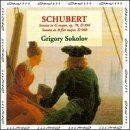| All Artists: Franz [Vienna] Schubert, Grigory Sokolov Title: Schubert: Sonata in G major; Sonata in B flat major Members Wishing: 3 Total Copies: 0 Label: Opus 111 Release Date: 2/10/1997 Genre: Classical Styles: Chamber Music, Forms & Genres, Sonatas, Historical Periods, Classical (c.1770-1830), Romantic (c.1820-1910) Number of Discs: 2 SwapaCD Credits: 2 UPC: 709861301485 |
Search - Franz [Vienna] Schubert, Grigory Sokolov :: Schubert: Sonata in G major; Sonata in B flat major
 | Franz [Vienna] Schubert, Grigory Sokolov Schubert: Sonata in G major; Sonata in B flat major Genre: Classical |
Larger Image |
CD DetailsSimilar CDs |
CD ReviewsA Russian master at his best Paul Geffen | 03/07/2001 (5 out of 5 stars) "The sonatas were recorded (live) in Helsinki in August 1992. Total time is about 84 minutes, hence the price (the same a single disc on this label).The G major sonata, D 894 is definitely played more slowly than is usual, but it does not drag. The interpretation is both colorful and episodic. The piece does not flow as well as it might given a steady tempo. Sokolov has great coloristic resources (technical ability to vary the timbre of the sound) but in this performance (and in the D 960) he makes frequent use of rallentando for emphasis. (These aren't in the score.)The great B flat sonata starts also quite slowly but soon comes up to the expected tempo. Sokolov exhibits his wide range of tone colors and gives special attention to inner voice lines. Tempos are sometimes slow to the point of risking continuity, but the arpeggios are all beautiful and delicate. In the trio of the scherzo he hits the sforzandi very hard, drawing attention away from the musical line, and breaking the flow; but the rest of the movement has the necessary finesse.The finale is fast, fleet, but somewhat unsteady. This music benefits from a well-defined beat. Sokolov has amazing technical control. I don't remember hearing a single wrong note. So it's clear that he means exactly what he says, and means it to sound as it does.The interpretations in general have heightened contrasts and saturated hues, a sort of Technicolor. ( I wonder if there isn't too much Sokolov in this performance, whereas someone like Kempff or Brendel can manage to get almost completely out of the composer's way.)Overall the timings of the movements show that Sokolov has in some cases stretched the "heavenly lengths" beyond what most other pianists have tried. But Richter's D 960, for example, is longer, and there are others which are even longer.The recording is generally very good, close up, with a little audience noise and little hall resonance.There are few pianists today with Sokolov's abilities. Argerich might generate more excitement if she dared to play these pieces, and Richter certainly took more obvious physical risks (and often fell short, though you could see what he was aiming for) when he tackled these works.For now, let's be grateful that the Russian School continues to produce masters such as this."
|


